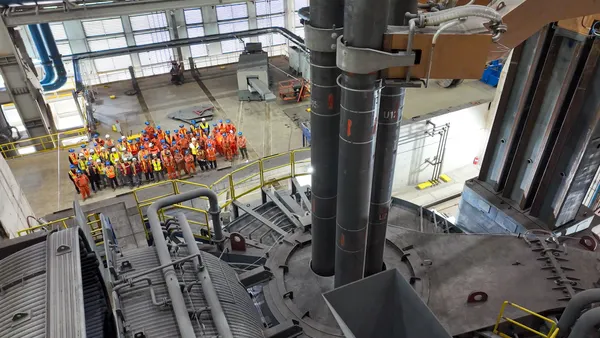Reliable power is mission critical for manufacturers, but it’s becoming increasingly more complicated to secure. As grid instability worsens and utility connection timelines stretch, many companies are turning to onsite generation. Yet not all solutions deliver the reliability, efficiency and sustainability that modern manufacturing requires. Choosing the wrong technology can cause costly delays, create friction with local communities and harm a company’s reputation.
Gas turbines and reciprocating engines have long been the go-to solutions for onsite power, but manufacturing demands are changing. With rising pressure to boost reliability, lower operating costs and reduce carbon emissions, fuel cells are emerging as the onsite power solution of choice.
Cleaner onsite power
Traditional onsite power solutions, like gas turbines and reciprocating engines, burn fuel to generate electricity. This combustion produces harmful pollutants, generates significant noise and consumes large amounts of water.
Fuel cells, by contrast, generate electricity through a direct electrochemical process without combustion. They run on natural gas but produce near-zero air pollutants such as NOx, SOx and particulate matter. They operate quietly and are often barely audible from a few feet away. They also require minimal water for steady-state operation. These characteristics make fuel cells easier to site near manufacturing facilities without creating community friction or permitting challenges.
Economics that add up
Despite common misperceptions, the cost-effectiveness of fuel cells for onsite power is on par with reciprocating engines and gas turbines.
“Fuel cells can often be the lowest cost source of power for a facility,” said Akhil Batheja, director of technology strategy for Bloom Energy. “This can lead to tremendous value through reduction of a manufacturer’s operating expenses.”
While upfront costs are about 10% to 15% higher for fuel cells compared to turbines or engines, the total cost of ownership is lower. Fuel cells operate 15% to 20% more efficiently than most open-cycle gas turbines and reciprocating engines, reducing fuel consumption and lowering annual operating costs.
Fuel cells also require less extra capacity — often called overbuilding — to ensure the facility meets its reliability targets. For example, to deliver 100 MW at three-nines (99.9%) availability, a gas turbine installation might need 130 MW to 150 MW of total capacity, and a reciprocating engine installation 120MW to 130 MW. A fuel cell system can achieve the same reliability with only about 109 MW. This efficiency in sizing reduces capital costs and improves overall cost-effectiveness.
Fuel cell technology also deploys rapidly, allowing manufacturers to begin generating revenue quickly. Bloom Energy can deliver 100 MW in as little as 90 days, with larger projects up to 500 MW completed in six months or less.
They are also highly reliable. Fuel cells connect directly to the underground gas network, which has a strong track record of consistent service, and their inherent redundancy eliminates the need for backup power. Plus, maintenance is simpler. Modules can be hot-swapped without shutting down the system, minimizing operational interruptions, protecting sensitive equipment and reducing downtime costs.
Power that scales with demand
Fuel cells provide manufacturers with flexible, scalable power that can grow alongside their operations.
“They are like Lego blocks for power generation,” said Batheja. “Facilities can add capacity incrementally to match evolving energy demands, ensuring they deploy just the right amount of power without unnecessary overbuild.”
Built from standardized 325 kW modules, fuel cell systems allow manufacturers to tailor the system size to their exact power needs. They can be installed as ground-mounted arrays or stacked in multi-level towers, adapting to available onsite space while maintaining efficiency regardless of system size. A 20,000-square-foot ground-mount facility, for example, can deliver 10 MW, while multi-level configurations allow facilities with limited real estate to achieve higher capacities.
The modular architecture also supports rapid expansion as manufacturing operations grow. Modules can be added sequentially without interrupting existing operations, allowing manufacturers to meet new load requirements quickly and cost-effectively. This flexibility is especially valuable for manufacturers facing fluctuating production schedules, expansions or future electrification initiatives.
The choice of good neighbors
Fuel cells help manufacturers maintain good relationships with surrounding communities while supporting the local grid. They reduce the need for new grid infrastructure by supplying power on site, which can offset peak demand and avoid costly upgrades to transmission and distribution lines. Fuel cells can also provide ancillary services, such as frequency regulation and voltage support, by adjusting output in real time to help stabilize the local grid.
Community acceptance is often a key consideration when siting onsite power. Unlike turbines or engines, fuel cells run quietly and produce near-zero local emissions, making them far easier to permit in sensitive areas. As Batheja put it, “Because fuel cells produce electricity without combustion, they avoid noise and emissions issues that often concern communities and permitting authorities.”
Fuel cells: A better path forward
Manufacturers can’t afford to leave power security to chance. Grid instability, long interconnection timelines, and rising sustainability pressures are making onsite generation essential. Gas turbines and reciprocating engines have played that role in the past, but they no longer align with modern manufacturing needs.
Fuel cells offer a better path forward. Bloom Energy’s Solid Oxide Fuel Cell (SOFC) Energy Server® power systems can be deployed behind or in front of the meter in various configurations and contracting models. With a 17-year record of proven reliability, Bloom has over 1.5 GW of installed capacity. Bloom’s modular architecture enables rapid deployment that is highly reliable, efficient and cost-effective. To explore how Bloom’s low-carbon, scalable and dispatchable solutions can support your organization’s energy goals, contact Bloom Energy.










